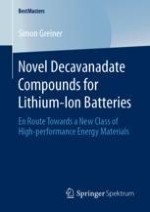2020 | Buch
Über dieses Buch
Simon Greiner investigates the molecular-level stabilization of polyoxovanadate (POV) compounds by rational design for the application as active cathode material in lithium-ion batteries. Formation of a complex hydrogen-bonding network locks the POVs in place and prevents thermal decomposition during electrode fabrication. The molecular vanadium oxide clusters can be electrochemically analyzed and show promising results for storage of multiple electrons per cluster, making these materials highly attractive for energy storage applications. Analytical methods comprise ATR-FTIR, powder and single-crystal XRD, electron microscopy, EDX, electrochemical analysis and battery testing.
Anzeige
